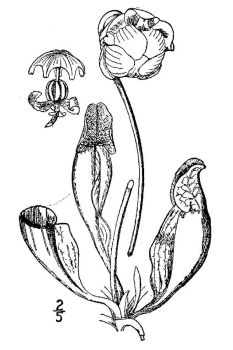Sarracenia purpurea
 |
 |
Photo Courtesy Renee Brecht |
Britton & Brown |
| Botanical name: | Sarracenia purpurea |
| Common name: | Purple pitcherplant |
| Group: | dicot |
| Family: | Sarraceniaceae |
| Growth type: | forb/herb |
| Duration: | perennial |
| Origin: | native |
| Plant height: | 8-24" |
| Foliage: | Evergreen hollow pitcher shaped leaves, varying from bright yellow-green to dark purple, often with a strong red venation. |
| Flower: | dark red to purplish red, 2" across |
| Flowering time: | May to mid June; fruits July to August |
| Habitat: | wet acid ground of sphagnum bogs, cedar swamps |
| Range in New Jersey: | throughout the Pine barrens, and north Jersey |
| Heritage ranking, if any: | n/a |
| Distribution: |  |
| Misc.: | Sarracenia, named
for Dr. Michel Sarrasin de l'Etang, 1659-1734, physician at the Court
of Quebec, who sent our northern species to Europe (Fernald, 729-see
Sources link). Purpurea, "purple". Sarracenia is a carnivorous plant. Insects become trapped in the pitcher-shaped leaves and drown in the rainwater that collects in the base of the leaf. Stiff, downward facing hairs make it virtually impossible for the insects to climb up the wall of the plant to escape. Besides insects, it also can capture and digest isopods, mites, and spiders. |